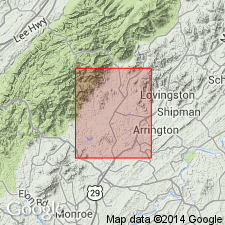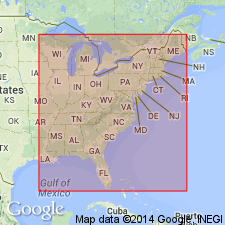
- Usage in publication:
-
- Lovingston massif*
- Modifications:
-
- Revised
- AAPG geologic province:
-
- Piedmont-Blue Ridge province
Summary:
Lovingston is here used informally as a "massif", following the usage of Bartholomew and others (1981).
Source: GNU records (USGS DDS-6; Reston GNULEX).

- Usage in publication:
-
- Lovingston Granite Gneiss*
- Modifications:
-
- Geochronologic dating
- AAPG geologic province:
-
- Piedmont-Blue Ridge province
Summary:
Used as Lovingston Granite Gneiss, a porphyritic granite or augen gneiss. Davis (1974) reports 207Pb/206Pb dates of 1032 and 1052 Ma from quartz monzonite and 1061 and 933 Ma from monzogranitic pegmatite, and U-Pb zircon upper intercept ages of 1080 Ma from same rocks.
Source: GNU records (USGS DDS-6; Reston GNULEX).
For more information, please contact Nancy Stamm, Geologic Names Committee Secretary.
Asterisk (*) indicates published by U.S. Geological Survey authors.
"No current usage" (†) implies that a name has been abandoned or has fallen into disuse. Former usage and, if known, replacement name given in parentheses ( ).
Slash (/) indicates name conflicts with nomenclatural guidelines (CSN, 1933; ACSN, 1961, 1970; NACSN, 1983, 2005, 2021). May be explained within brackets ([ ]).

